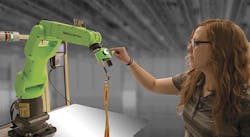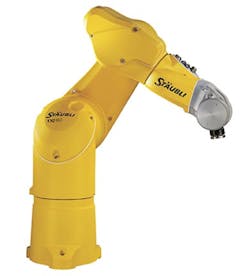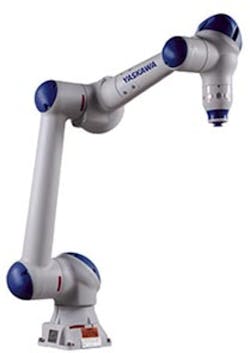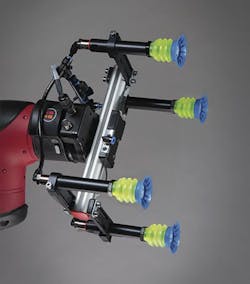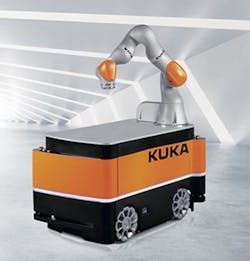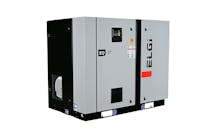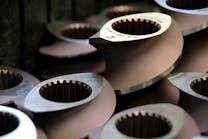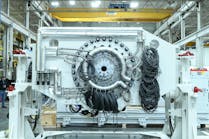Collaborative robots, also referred to as cobots, are increasing in popularity in part because of improving technology. The ability to cost-effectively deploy a cobot is adding to the growing market demand.
Large industrial robots are separated from human workers by fencing or other barriers. But collaborative robots can eliminate the need for expensive fencing, which takes up valuable floor space.
"Human-robot collaboration is the new, wanted characteristic for robots," said Bernardo Mendez, senior product manager for Yaskawa Innovation Inc., Austin.
Along with Yaskawa Motoman, Fanuc and Stäubli have recently announced innovations involving six-axis cobots. Meanwhile, two collaborative robot manufacturers — Rethink Robotics and Kuka Robotics — have unveiled new developments involving seven-axis cobots.
Fanuc
Fanuc recently released a smaller line of power-and force-limiting collaborative robots, the six-axis CR-4iA, CR-7iA and CR-7iA/L.
The robots are ideal for small part sorting and assembly, inspection, machine tending and part delivery, according to the company. They can be used for part removal.
The cobots are modeled on the previously released CR-35iA cobot, which has a 77.2-pound payload and was the first robot of its payload capacity that could work with humans in a shared space, according to the company.
"Our collaborative robots are equipped with highly sensitive contact detection, allowing them to share workstations with people," said Greg Buell, Fanuc America senior engineer for collaborative robots.
The CR-7iA features a 28.2-inch reach and 15.4-pound payload; the CR-7iA/L features the same payload with a longer 35.9-inch reach; and the CR-4iA has a 21.7-inch reach and 8.8-pound payload. The robots are available with floor, wall and ceiling mounting options and are designed to meet the safety requirements of ISO 10218-1:2011 and RIA/ANSI R15.06-2012.
In the middle of last year, Fanuc also released a hand-guiding option for the CR-35iA cobot; it gives users the ability to fully control robot motion through a handle mounted at the faceplate of the robot. This method of robot teaching allows an operator to simply guide the robot through motion paths. It makes it easy to teach a CR-35iA collaborative robot, without the need for conventional programming. It can be used to assist workers with heavy lifting, Buell said.
All of Fanuc's collaborative robots are green to distinguish them from the standard yellow Fanuc robots. However, the collaborative robots share the same software and are as reliable and easy to maintain, Buell said.
The company is reporting increased interest from customers in cobots.
Stäubli
Stäubli in April introduced its new TX2 line of collaborative robots to the U.S. market at the Automate trade show. The TX2 cobots incorporate the company's new CS9 safety controller, which "opens a new chapter in man-robot collaboration," according to the company.
"This robot and this new controller … [are] a completely ground-up redesign of our product line," said Paul Deady, Stäubli's automotive segment manager. "It was completely built from the ground up with safety as the paramount part of the design."
The company's six-axis cobots have separate digital safety encoders for each axis. Safety encoders monitor the robot's speed, direction and position and provide feedback if conditions meet a predefined unsafe state. For additional safety, there are backup encoders for each axis. Also, dual CPUs are responsible for the path planning.
"Everything that has to do with the path planning is completely redundant," Deady said.
In addition, all the coordinates of the cobot, as well as its speed and acceleration, are monitored in real time.
The new TX2 line has six models: TX2-40, TX2-60, TX2-60L, TX2-90, TX2-90L and TX2-90XL. Payloads for the line range from about 4.4 pounds to 44 pounds, and reaches range from about 20.3 inches to 57 inches.
The new six-axis robots have IP65 and IP67 ratings, certifying them as sealed against liquid and dust intrusions. That makes the TX2 series well-suited for use in clean rooms and harsh environments, according to the company.
Yaskawa Motoman
Yaskawa Motoman's new six-axis HC10 robot features power- and force-limiting technology that allows the robot to work safely with or in close proximity to humans.
Dual-torque sensors in all joints constantly monitor force to quickly react to contact, a feature that usually is found only in more expensive robots, according to the company. The feature prevents injury to a body part if it is caught in one of the robot's joints.
"If an external force acts on a joint, the joint will submit itself to this force," Mendez said. "So, in case of a collision, the joint will move in the opposite direction, avoiding any injury."
Through-arm utilities hide cables and increase safety by reducing the risks of snagging or interference with other equipment.
The company's Easy Touch software allows users to hand-guide the HC10 robot while teaching new program paths, allowing the robot to be deployed or redeployed quickly and increasing return on investment.
The HC10 features a 22-pound payload and a 47.2-inch reach. It can perform a range of material- handling, machine-tending and light-assembly tasks.
"There are some processes in the plastics industry that are ideally suited for the collaborative nature of the HC10," Mendez said. "In high-mix and low-volume situations, humans usually have to do tedious activities that require a constant and steady flow. Human nature will always create variations and ambiguity."
People who work with the HC10 can focus more on the cognitive tasks within the process, Mendez said.
Specific applications could include part removal, machine tending, packaging and palletizing.
Rethink Robotics
While a six-axis robot is able to reach every location available within a space, adding a seventh axis allows the operator to arrive at an end position with several different configurations.
"Any six-degree-access robot can get to a certain spot in a certain orientation with its hand or end effector," said Jim Lawton, chief product and marketing officer with Rethink Robotics, the maker of the Sawyer robot. "A seven-degree robot can get there in multiple ways."
This can be useful if someone is trying to incorporate a robot into an existing cell. If there is an object blocking the robot's motion, a seventh axis can offer a means of going around the object.
In February, Rethink Robotics introduced Intera 5, a major upgrade of the robot's software that allows a robot to control an entire work cell and simplifies automation through a single controller.
Intera 5 allows manufacturers to deploy full work cell automation in a matter of hours, not weeks.
"With the introduction of Intera 5, we've created the world's first smart robot that can orchestrate the entire work cell, removing areas of friction and opening up new and affordable automation possibilities for manufacturers around the world," said Scott Eckert, president and CEO of Rethink Robotics.
The new software allows a manufacturer to run conveyors, an injection molding machine and other equipment using an Intera 5-powered robot's controller. With it, users can synchronize production equipment without having to program individual PLCs, which can be time-consuming and require employees with specialized knowledge.
Based on customer feedback, Rethink Robotics decided to expand the simplicity of programming its robots to other equipment in production cells, according to the company.
Sawyer robots do not require traditional programming, which can take 200 to 300 hours. Instead, a worker grabs Sawyer's arm and shows it what to do. Once that's done, the robot will repeat and optimize the motions.
"It's almost like on-the-job training," Lawton said. "You show the robot how to perform the task, and then it does it. In a lot of cases, we can deploy robots really rapidly."
Customers told the company they wished they could get the rest of their work cell to work as simply and easily as the robot, Lawton said. The company realized it could provide that benefit.
"As we looked toward the expansion of Intera, we've made sure to architect it in such a way you can think very holistically about the entire work cell and can organize that activity in the Intera software," he said. "So, the conveyor is just another node inside the behavior structure built into Intera 5. The CNC machine and the plastic injection molding machine, they're all just other pieces or elements within the robot's purview."
The result is the robot can start, stop and otherwise control and synchronize the production equipment. For example, if cameras on a Sawyer robot inspecting manufactured parts determine an injection molding machine has started making defective parts, the robot can shut down the machine and related equipment and alert a supervisor of the problem. In some cases, Sawyer might even be able to diagnose and fix the problem.
"Depending on the nature of the problem, if there is a specific logic that the robot understands in terms of what to do next, it can then branch and perform that other additional set of logic," Lawton said. "The fact the robot can organize the activities within the work cell provides just so much more flexibility than what you can get deploying them in a more traditional way."
Sawyer robots are used in the plastics industry for functions including inspecting, sorting and kitting parts, packing, and unloading, Lawton said.
Intera 5 is available for download on all existing Sawyer robots and will come standard on all new robots.
In another development in April, Rethink Robotics launched the ClickSmart series, a unique solution for end-of-arm tooling (EOAT) that incorporates smart sensing and rapid swapping capabilities.
The ClickSmart series features the new ClickSmart Plate, a tool plate that lets users swap end effectors in seconds, by hand and without any tools. Embedded sensors in the five new gripper kits enable intelligent grasping and smarter part handling on Rethink Robotics' Sawyer robots powered by Intera 5 software.
When a human first puts new EOAT on a robot, he or she educates it on how to use it.
"Then, once you do that, whenever you use it in the future, that information is stored into the hand of the robot and it transfers the information to the robot so it knows how to use it," Lawton said.
Even when the gripper is reattached after removal, the robot requires no retraining. This allows for simple swapping out of gripper kits for distinct functions.The gripper kits are available in large pneumatic, small pneumatic, large vacuum, small vacuum and foam vacuum options.
Kuka Robotics
Kuka Robotics recently unveiled its KMR iiwa mobile seven-axis robot. New technology frees the units from the traditional, permanent factory-floor mounts that normally restrict other robots.
The company highlighted the new robot in April at Automate.
The KMR iiwa pairs the company's lightweight, collaborative LBR iiwa robot with the KMR mobile platform that features mecanum wheels, which can move a robot in any direction. The omnidirectional wheel technology allows the KMR iiwa to move safely to a desired position, even in confined spaces, with a positioning accuracy of up to 1mm.
Making the robot mobile reduces manufacturing process times and idle times, and ensures it is used to its full potential, according to the company.
The KMR iiwa includes an autonomous and safe navigation system that incorporates laser scanning monitors and live-mapping so that the robot reacts immediately if a person or object moves into its path.
The robot works directly with humans and can serve as the operator's third hand. High-performance batteries remove the restrictions of complex cabling. The robots are available in two payloads: 15.4 pounds and 30.9 pounds, with reaches of 31.5 inches and 32.3 inches.
Also in February, Kuka unveiled Kuka Connect, its new cloud-based software that provides customers access to analytics involving their robots anytime, anywhere and on any device. It is a subscription-based service that provides visibility into connected Kuka robots without the need to install any additional software, according to the company.
Kuka Connect can provide information about the current state of robots, fault notification, exportable data reports and a comprehensive event log, according to the company.
Bruce Geiselman, senior staff reporter
bgeiselman@plasticsmachinerymagazine.com
For more information
Fanuc America Corp.,Rochester Hills, Mich., 888-326-8287, www.fanucamerica.com
Kuka Robotics Corp.,Shelby Township, Mich., 866-873-5852,www.kuka-robotics.com
Rethink Robotics Inc.,Boston, 617-500-2487,www.rethinkrobotics.com
Stäubli Corp.,Duncan, S.C., 864-433-1980,www.staubli.us
Yaskawa America Inc., Motoman Robotics Division,Miamisburg, Ohio, 937-847-6200,www.motoman.com
Bruce Geiselman | Senior Staff Reporter
Senior Staff Reporter Bruce Geiselman covers extrusion, blow molding, additive manufacturing, automation and end markets including automotive and packaging. He also writes features, including In Other Words and Problem Solved, for Plastics Machinery & Manufacturing, Plastics Recycling and The Journal of Blow Molding. He has extensive experience in daily and magazine journalism.
